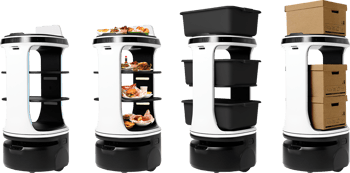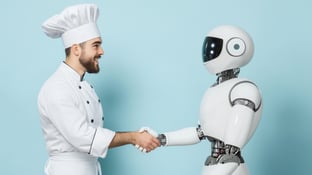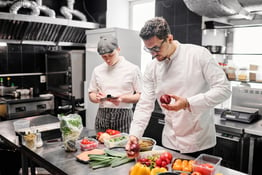Artificial intelligence (AI) is inescapable. We’re all hearing about it every day, with new solutions emerging all the time, in nearly every industry. “But I feed people,” you may think. “What does AI have to do with the restaurant business?”
Let’s take a look at some answers.
The Rise of AI in the Restaurant Industry
According to the National Restaurant Association’s latest survey, more than a quarter (28%) of restaurant operators plan to make strategic investments in technology this year. The other 72% can’t afford to wait much longer. Far from being a sci-fi tool, AI is increasingly a must-have for restaurateurs looking to do more work with less effort and to maintain efficient, cost-effective operations.
Restaurant Industry Challenges That AI Can Help Address
What’s keeping restaurant operators up at night? While the industry constantly evolves, the same three challenges continue to plague it.
- Food waste: The United Nations estimates that at least $2.5 trillion worth of food — about a third of all food produced worldwide – goes to waste every year. If your ordering and inventory management processes are inefficient, they can make the waste issue much worse, causing significant financial losses for you and an outsize contribution to this global crisis. Fortunately, AI promises to offer insights for addressing food waste in the kitchen, helping restaurants to grow greener and more efficient.
- Inflation: People around the country are spending more to put food on the table and inflation hasn’t spared the restaurant industry. The National Restaurant Industry reports that the last four years have seen a 31% rise in food costs and a 29% rise in labor costs. These expenses have forced many operators to charge more for familiar dishes.
- Staff turnover: The National Restaurant Association says that open roles are back down to pre-pandemic levels and that employee turnover is at its lowest point in years. Tell that to a struggling operator! Though turnover may not be your biggest problem, you can’t ignore issues around keeping staff. Using the right tech can help make restaurant work easier and more satisfying and can ensure your employees stay engaged and happy.
Just because everyone is experiencing a challenge doesn’t mean there’s nothing you can do to solve it. AI-powered tools can help you with everyday issues, but they can also give you a competitive advantage. While AI can’t directly “solve” inflation, it can provide efficiency boosts that produce enough savings to offset inflation’s impact.
The Benefits of Implementing AI in Restaurant Kitchens
AI solutions for restaurant kitchen efficiency let you:
- Boost efficiency and productivity: Automating and optimizing tasks with AI helps your kitchen staff work faster without working harder.
- Increase order accuracy and food quality: AI-enabled technology for monitoring cooking conditions and recipe compliance ensure food consistently meets quality and safety standards to keep customers coming back.
- Reduce food waste: With data-driven insights for preventing overproduction and optimizing inventory levels, AI can drive down food waste and its associated costs.
- Enhance the customer experience: AI-powered solutions can also gather plenty of data on your returning customers to help you tailor service and fine-tune your loyalty programs.
- Improve the employee experience: Your employees will thank you for implementing new AI-based solutions, too. Offloading repetitive work to AI will mean staffers have more time to focus on high-value, high-satisfaction work.
This all sounds amazing – but you’re a restaurant operator, not a tech bro. How can you reap these benefits? By finding the providers who have built the apps that simplify your work life.

Stay in the Loop
Short and sweet summaries for busy restaurant operators. Subscribe to the Back of House newsletter to get updates delivered straight to your inbox.
*Submitting this form will subscribe you to our weekly newsletter. Unsubscribe at any time.
How AI Can Improve Kitchen Efficiency and Performance
The right technology has the potential to transform every aspect of your day-to-day kitchen operations. Here’s just a sampling of what new AI solutions for restaurant kitchen efficiency could bring.
AI-Powered Inventory Management
Bringing advanced computer vision applications to your walk-ins and storage rooms can track inventory levels in real time and automate ordering to avoid disruptive shortages.
At the front of the house, custom-built computer vision models can help track how fast popular dishes are selling. They can also send information to kitchen employees to ensure hungry diners are never left waiting on their favorites.
Automated Food Preparation and Dishwashing
Robots are boosting back-of-house productivity and helping operators cut back on labor costs by automating repetitive tasks. As AI collects more data and learns more lessons, it can grow faster and more accurate as it assists your kitchen employees.
Smart Scheduling and Staffing Optimization
When your staffing levels don’t match restaurant traffic, you are either over-staffing, which is a waste of money, or under-staffing, which makes for unhappy customers and unhappy employees. Solutions like 7Shifts arm you with the necessary data for making more informed scheduling decisions.
Take the weather. Great weather can cause an increase in business in some locations, especially where outdoor dining is popular, but if you’re connected to a large indoor mall, sunny weather will most likely hurt your business.
Or maybe a nearby college is having a parents’ weekend, which will drive a lot of business for you. The right tech will tell you about weather, local events, and more ahead of time so you can add or subtract people from the schedule.
AI for Quality Control and Food Safety
Here’s another area where computer vision is playing a growing role. A vision AI model can, for example, confirm the presence of personal protective equipment like gloves and hairnets or monitor prep processes to ensure a job well done.
Predictive Maintenance for Kitchen Equipment
An equipment failure at the wrong time could bring your kitchen to a halt and leave scores of customers disappointed. AI-powered monitoring can offer insights to make maintenance more proactive and stop breakdowns before they can occur.
What to Consider Before Implementing AI in Your Kitchen
The potential benefits of AI are obvious, but obviously you want to think about it before opening your wallet. Here are four issues to consider.
Costs of Implementation and Ongoing Management
Introducing AI will mean making a significant upfront investment. And don’t forget about recurring costs like subscription fees. If you don’t account for AI’s expenses upfront, you could break the bank before you’ve even seen the benefits of your new solution.
Take the time to do the math to calculate the potential ROI (return on investment) of new solutions to see if the solution makes sense for where you are now.
Integration With Your Existing Systems
AI-powered solutions run on data, and that data is supplied by you. This doesn’t mean you’re punching in numbers by hand — the new solution will be integrated with your existing systems, like your POS (point of sale). If the AI-based solution isn’t getting the relevant data, it’s useless.
Most of these solutions are designed to be integrated with applications from major brands, but you need to know in advance what you’re already using and how it would connect. This is something I (or another Back of House tech consultant) can help you with.
Training and On-Boarding Support
It takes time to learn new solutions and adjust to new AI-supported processes. Once you decide to move ahead with an AI solution, plan carefully how you’ll bring it online. Build in time for training and on-boarding so that your team can learn the ins and outs of your new tech and confidently interact with their new digital coworkers.
Balancing Automation with Human Creativity
AI is capable of incredible things, but it’s no replacement for human creativity and intelligence — AI is not going to start writing your menu for you (unless you really want it to).
As you review new solutions, take care to find the appropriate balance between automated efficiency and human-driven ingenuity. Remember, automating tasks doesn’t mean you’re replacing your back of house team. It means you’re freeing up your employees to focus on the guest (the number one priority) by taking away mundane, repetitive tasks.
Let’s Talk Tech Trends Today
Want to learn more about AI solutions for restaurant kitchen efficiency? Let’s put some time on the calendar to discuss the ways Back of House’s trusted tech partners can help you stay ahead of evolving trends, devise creative strategies for satisfying your customers, and consistently grow more efficient.





